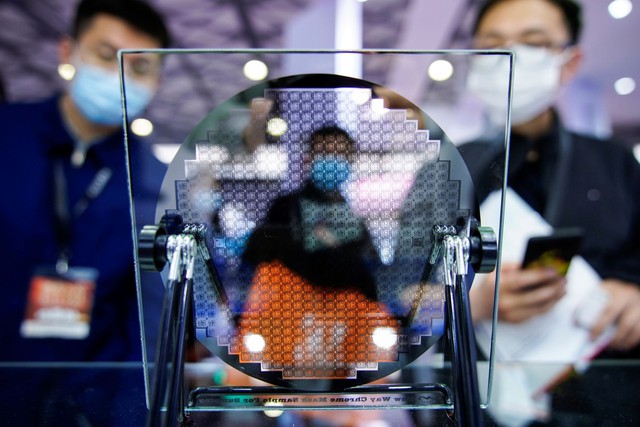The ‘Achilles Heel’ of China’s chip industry
- Tram Ho
On August 10, shortly after US President Joe Biden signed the Chip and Science Act, which set aside $52.7 billion for semiconductor research and production, China’s Foreign Ministry criticized it as a fraud. another example of the “economic coercion” of the US.
The Global Times said that the law was introduced to cripple China’s semiconductor supply chain.
Foreign dependency
China’s response partly reflects its concerns that Washington will seek to stop Beijing from reaching the pinnacle of semiconductor technology. In the past time, the US has been doing that when targeting China’s weakness in this area.

Currently, the global semiconductor value chain consists of about 300 input components supplied by dozens of countries. Among them, a very important component is the lithography equipment used to produce chips.
According to The Diplomat , lithography – the process of printing integrated circuit patterns onto silicon wafers – is a notable weakness of the Chinese chip industry.
The Chinese industry is generally uncompetitive in the semiconductor manufacturing equipment (SME) and electronic design automation (EDA) sectors.
Currently Shanghai Microelectronics (SMEE) – China’s sole lithographic printer manufacturer – is mass producing devices using the 90 nanometer (nm) process and has developed 14nm machines.
Despite the impressive results, SMEE is still far behind the Netherlands-based global lithography leader ASML. ASML manufactures machines capable of etching cutting-edge chips below 7nm.
Faced with barriers from knowledge to investment, Beijing’s best option is to continue buying from ASML. This dependence is emerging as a growing risk for Chinese chipmakers.
In January 2021, the Center for Security and Emerging Technologies (CSET) in the United States released a report stating that China’s weaknesses in SMEs, EDA software, intellectual property in chip design, and materials Advanced data has created “a policy opportunity” for the US.
Washington could exploit this opportunity by introducing export and investment controls.
American control strategy
To slow China’s progress in semiconductors, the US has now increased restrictions on all inputs that contain significant US-origin technology (such as lithography equipment). version) through the Foreign Direct Product Regulations (FDP).
Since 2020, the US has targeted China’s weakness in the lithography sector by banning the sale of advanced ultraviolet lithography (EUV) machines and is now considering a more comprehensive ban on the devices.
In February, Chinese lithography maker SMEE and 32 other Chinese units were placed on an export watch list by the US Department of Commerce.
In response, China’s Foreign Ministry in July called the strategy “coerced diplomacy” and “technological terrorism”, after Bloomberg News reported that the US was lobbying its allies to stop selling public goods. chip manufacturing technology for China.
Despite US restrictions on EUV machines, China Semiconductor Manufacturing International Corporation (SMIC) has been able to produce certain specialty chips at the 7nm level (albeit with commercial output). limited commercialization) using the older generation DUV photolithography.
DUV is an older technology than EUV, but is still important to the 28nm production line that is a mainstay for top Chinese chipmakers like SMIC.
However, China’s ambitions to go further in the semiconductor industry could be threatened, if Washington successfully expands export and investment controls to key technologies, such as DUV.
Currently, in addition to the giant lithography company ASML, the US is also putting pressure on Japan’s Nikon and Canon to limit DUV exports to China.
How to produce semiconductors?
According to electronic components company Matsusada Precision, the semiconductor manufacturing process is similar to that of small card-shaped items, such as business cards. Producing a business card involves the design step, printing the design onto a large sheet of paper, and finally cutting it into individual business cards – the process is similar for semiconductors.
Semiconductor manufacturing consists of a design phase, a “front-end” stage and a “back-end” phase. In it, semiconductors will go through the design phase, and large-scale integrated circuits (LSIs) are created on silicon wafers in the front-end stage. The integrated circuit is then cut into individual chips in the back-end stage.
Source : Genk
